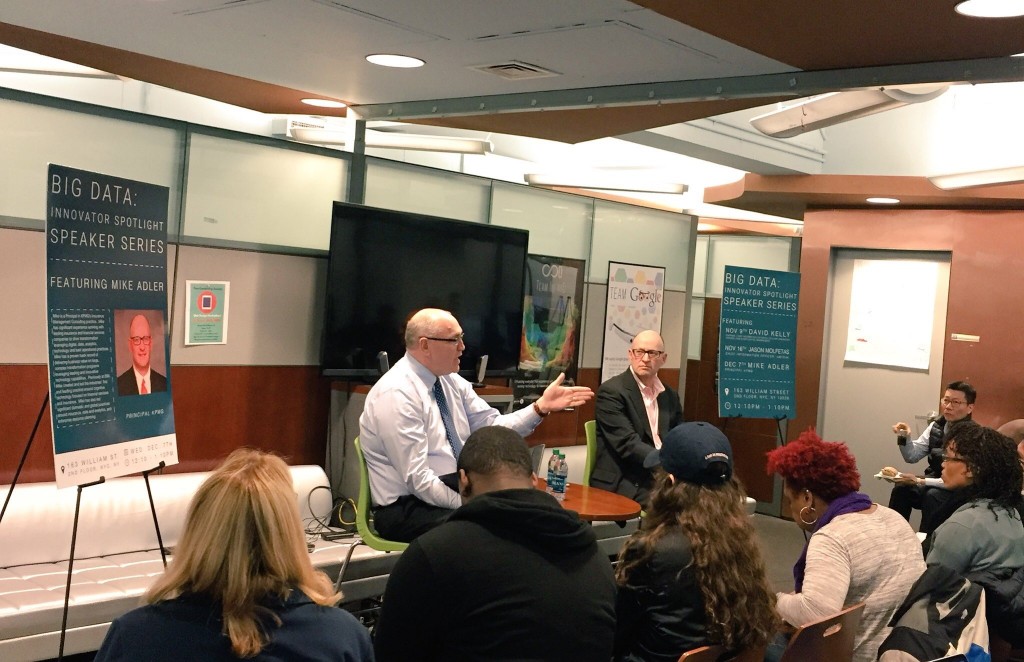In the STEM world, there are few places that will make people gasp with awe. CERN is one of them, and during one special week in December, several Seidenberg staff and faculty were there.
CERN is one of the world’s largest and most respected centers for scientific research. It’s also home to a Design Factory, which this year was the host of International Design Factory Week, an annual meeting of Design Factories around the globe to collaborate, bond, and have a good time with other members of the network.

Why were we there?
Pace University recently opened our very own entrant into the Design Factory Global Network (DGFN) – the NYC Design Factory. The purpose of these factories is to build a space within a community where members can research, collaborate, give and get feedback, and ultimately develop excellent ideas and products that solve problems. They do so using a methodology called Design Thinking, a non-traditional way of working that we hope to bring into the mainstream through NYC Design Factory and across the greater Seidenberg and Pace community.
But back to CERN. Delegates from Seidenberg included Dean Jonathan Hill, Professor Stacey Sarris, and Program Manager Olga Bogomolova. They flew out to Geneva, Switzerland, over the weekend preceding the Dec 12th kickoff.

Checking out CERN
So what did our envoys think? “CERN was the perfect backdrop for a collaborative Design Factory global event given that CERN is proof that anything is possible and that’s what Design Factory is about!” said Professor Stacey Sarris.
“CERN is this amazing, dynamic place with thousands of scientists – most of them physicists with some computer scientists sprinkled in – who are working on some of the largest physics problems in the world today. You can’t not be inspired spending a day there among the world’s top science minds,” Dean Jonathan Hill said.

Do you want to collaborate?
45 people from 15 countries attended the event. Olga explained the benefits of having an annual get together. “We all have strengths and areas of focus, so when we get together we can exchange ideas and best practices and brainstorm ways of working together. Because we are so different, we can leverage our differences to create a wholesome experience for our students.
There are 16 universities or institutions around the world that think similarly and practice design thinking, project based learning; we have a similar way of thinking and doing things. By getting to know each other, you learn that if you want to work with an institution in Australia, Korea, China, Columbia, and so on, I can just send someone from that country’s design factory a message and say ‘I have an idea, do you want to collaborate?’
Just knowing that even if you don’t know someone in the country there is an institution of people that think the same way as you… it breaks down barriers. The week is great because we get to meet each other as human beings, which helps us work together.”

Top secret
International Design Factory Week has several goals. The first one is to meet and get to know one another. People were spending 10-16 hours per day with each other, so that wasn’t difficult! The second goal was to come up with a project for everybody to work on together. “There’s so many of us, covering the whole world and different timezones. Coming up with a project to leverage the whole network sounds difficult, but we did it,” said Olga. “It’s top secret.”
Top secret? Yeah, right – we found your Mannequin Challenge video, DFGN! We know what you really got up to! Just kidding – but watch their amazing video below!




 Once they had arrived at the Aalto Design Factory, it was time to get started. Attendees met teammates and participated in PD6 – product development in 6 hours. Everyone was then split into two teams: KONE, an established elevator company, and Seecode, a tech startup.
Once they had arrived at the Aalto Design Factory, it was time to get started. Attendees met teammates and participated in PD6 – product development in 6 hours. Everyone was then split into two teams: KONE, an established elevator company, and Seecode, a tech startup.
 On the following days it was time to get down to work!
On the following days it was time to get down to work!
 “We are excited to be a part of this amazing project and willing to put our 100% effort to achieve the final outcome of the project and present it in the gala”, said Mansoor. “We thank Pace University for selecting us for the Product Development Project and we feel it’s a great honor representing Pace University in a global event.”
“We are excited to be a part of this amazing project and willing to put our 100% effort to achieve the final outcome of the project and present it in the gala”, said Mansoor. “We thank Pace University for selecting us for the Product Development Project and we feel it’s a great honor representing Pace University in a global event.”








